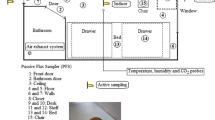Abstract
The paper presents the construction and metrological characteristics of the home-made in situ passive flux sampler, an analytical tool representing small-scale emission chambers working in situ and passively sampling analytes from the gaseous phase. The sorption element was a cylindrical container made of stainless steel net, packed with a carbon sorbent bed-graphitized charcoal, Carbograph 4 (35/50 mesh). The recommended working/exposure time of the constructed passive device was determined by carrying out model tests in the laboratory. In addition, a preliminary study was conducted to determine the rate of the emission flux of selected monoterpenes released from the surface of wood-based indoor materials (laminated chipboard) used in residential areas.


Similar content being viewed by others
References
Kim JA, Kim S, Kim HJ, Kim YS (2011) Evaluation of formaldehyde and VOCs emission factors from paints in a small chamber: the effects of preconditioning time and coating weight. J Hazard Mater 187:52–57
Han KH, Zhang JS, Wargocki P, Knudsen HN, Varshney PK, Guo B (2012) Model-based approach to account for the variation of primary VOC emissions over time in the identification of indoor VOC sources. Build Environ 57:403–416
Gallego E, Roca JF, Perales JF, Guardino X (2013) Experimental evaluation of VOC removal efficiency of a coconut shell activated carbon filter for indoor air quality enhancement. Build Environ 67:14–25
Marć M, Zabiegała B, Namieśnik J (2012) Testing and sampling devices for monitoring volatile and semi-volatile organic compounds in indoor air. Trends Anal Chem 32:76–86
Marć M, Zabiegała B, Namieśnik J (2013) Miniaturized passive emission chambers for in situ measurement of emissions of volatile organic compounds. Crit Rev Anal Chem 43:55–61
Plaisance H, Blondel A, Desauziers V, Mocho P (2014) Characteristics of formaldehyde emissions from indoor materials assessed by a method using passive flux sampler measurements. Build Environ 73:249–255
Shinohara N, Fujii M, Yamasaki A, Yanagisawa Y (2007) Passive flux sampler for measurement of formaldehyde emission rates. Atmos Environ 41:4018–4028
Kang DH, Choi DH, Lee SM, Yeo MS, Kim KW (2010) Effect of bake-out on reducing VOC emissions and concentrations in a residential housing unit with a radiant floor heating system. Build Environ 45:1816–1825
Yamashita S, Kume K, Horiike T, Honma N, Fusaya M, Ohura T, Amagai T (2010) A simple method for screening emission sources of carbonyl compounds in indoor air. J Hazard Mater 178:370–376
Ni Y, Kumagai K, Yanagisawa Y (2007) Measuring emissions of organophosphate flame retardants using a passive flux sampler. Atmos Environ 41:3235–3240
Fujii M, Shinohara N, Limb A, Otake T, Kumagai K, Yanagisawa Y (2003) A study on emission of phthalate esters from plastic materials using a passive flux sampler. Atmos Environ 37:5495–5504
Marć M, Namieśnik J, Zabiegała B (2014) Small-scale passive emission chamber for screening studies on monoterpene emission flux from the surface of wood-based indoor elements. Sci Total Environ 481:35–46
Sekine Y, Toyooka S, Watts SF (2007) Determination of acetaldehyde and acetone emanating from human skin using a passive flux sampler—HPLC system. J Chromatogr B 859:201–207
Uhde E, Salthammer T (2007) Impact of reaction products from building materials and furnishings on indoor air quality—a review of recent advances in indoor chemistry. Atmos Environ 41:3111–3128
Marć M, Zabiegała B, Namieśnik J (2014) Application of passive sampling technique in monitoring research on quality of atmospheric air in the area of Tczew, Poland. Int J Environ Anal Chem 94:151–167
Acknowledgments
The study was funded by the Ministry of Science and Higher Education under the “Iuventus Plus” programme for the years 2015–2017, project no. IP2014 028373.
Conflict of interest
The authors declare that they have no competing interests.
Author information
Authors and Affiliations
Corresponding author
Rights and permissions
About this article
Cite this article
Marć, M., Namieśnik, J. & Zabiegała, B. The home-made in situ passive flux sampler for the measurement of monoterpene emission flux: preliminary studies. Anal Bioanal Chem 407, 6879–6884 (2015). https://doi.org/10.1007/s00216-015-8859-z
Received:
Revised:
Accepted:
Published:
Issue Date:
DOI: https://doi.org/10.1007/s00216-015-8859-z




